A plate of creamy scrambled eggs is arguably one of the greatest breakfast joys out there. Light, fluffy, and delicious, they can truly elevate any plate or even take center stage, but they’re notoriously hard to get right. Eggs tend to become dry and sometimes rubbery if they’re overcooked even slightly, and they can be particularly tricky to cook in bulk, often requiring a keen eye to ensure they don’t dry out. This may not be true, however, if you’re using a slow cooker. These handy kitchen appliances lend themselves to cooking perfectly moist scrambled eggs of any portion size that will remain warm until they’re served up. The best part? This method requires practically no effort but yields delicious results.
Your slow cooker isn’t just useful for preparing scrambled eggs, either — you can also use it to batch-cook boiled eggs for busy days or make perfectly poached eggs with gooey golden yolks, all while keeping your kitchen as mess-free as possible. So, if you’re looking for a tasty brunch that you can leave to cook overnight, or if you want to ensure that your breakfast plans go off without a hitch, here’s how to get the most out of cooking eggs in your slow cooker.
Use butter to grease your slow cooker

The last thing you want after making perfect eggs is for them to stick to the bottom of your slow cooker. Not only does this result in more clean-up, but you’ll also end up with dry, crispy patches of egg that need to be scraped off. The best way to avoid this — and to ensure silky-smooth eggs that remain intact both during and after cooking — is to properly prep your machine by giving it a generous coating of fat. While oil and non-stick spray are popular and perfectly functional choices when cooking eggs in a pan, butter is best when you’re preparing your eggs in a slow cooker.
Non-stick sprays only provide a thin layer of grease that won’t keep eggs from sticking to your slow cooker for the extended period the device requires. A liberal amount of butter, however, which is slightly fattier than oil, when spread on the bottom and sides of the slow cooker, will help eggs come away easily. This method will also impart butter’s signature richness and delicious taste for an even better flavor.
Opt for whole eggs instead of egg whites
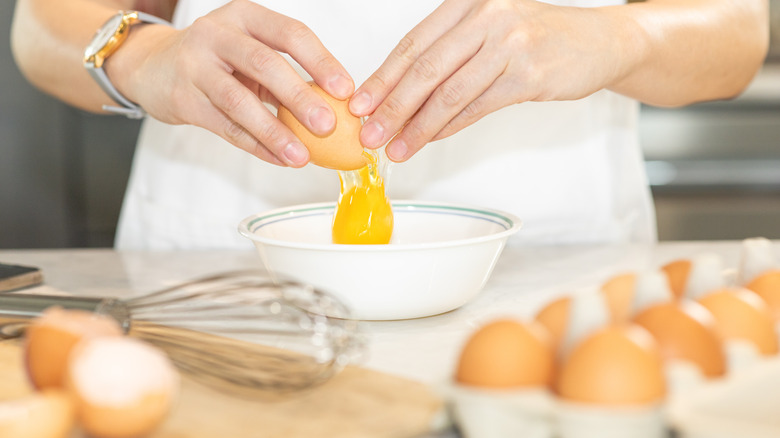
Though egg whites can be a great choice if you’re looking for a reduced-fat, low-calorie breakfast, particularly when you whisk them up in an omelet with a bunch of other fresh ingredients, they don’t work as well in a slow cooker as they do on the stovetop. This is because egg whites are mostly water, and this composition means they won’t stay moist during extensive cooking periods; rather, they become dry and rubbery as their water evaporates.
So, if you’re using a slow cooker, stick to whole eggs — whether they’re scrambled, boiled, or poached — for guaranteed creaminess and moisture. The yolk is the egg’s source of fat, but it also contains a vast range of vitamins and nutrients that make it worthwhile to include in your recipes, both for flavor and nutrition. If, however, you’re eager to increase the protein in a breakfast casserole without adding calories, treat the egg whites as extra ingredients and mix them with whole eggs. Alternatively, you can combine the whites with an additional source of moisture such as yogurt, as long as you keep in mind any potential volume difference.
Add cream for silky scrambled eggs
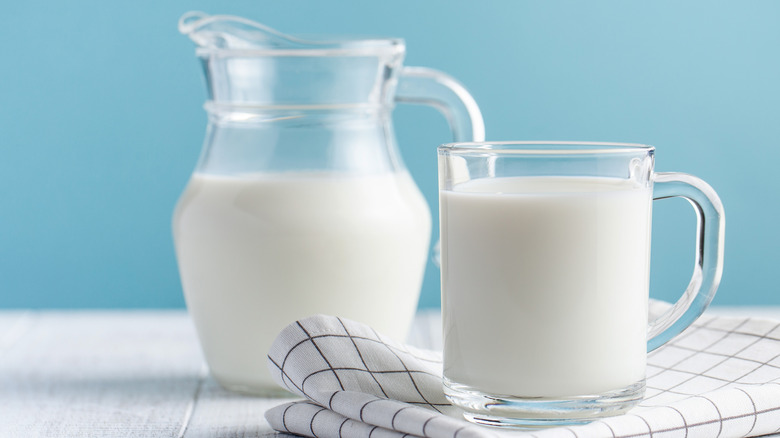
While adding milk to beaten eggs is, for many home chefs, a non-negotiable step when prepping a scramble, this may have an adverse effect that’s only heightened by your slow cooker’s long cooking times. Beaten eggs become diluted when combined with liquid, and that thinner texture means they lose a lot of their signature taste. Though you may be able to salvage such eggs on a stovetop, it’s harder to keep an eye on them in a slow cooker, so choosing the right dairy is an important part of ensuring successfully scrambled eggs.
Combining beaten eggs with buttermilk, which is thicker than regular milk, can make a fluffy product, but heavy cream is the best choice for minimizing the amount of escaped moisture, securing rich and creamy results. A dash of heavy cream added near the end of the cooking process can also keep your eggs from drying out until you’re ready to serve, which is particularly useful if they’re sitting in a still-warm slow cooker.
Cook scrambled eggs on a low setting

Powerofforever / Getty Images
You may be used to scrambled eggs taking five minutes or less in a pan, but low and slow is the way to go if you want perfect results with a slow cooker. Since eggs can easily dry out during cooking (and are pretty much unsalvageable once they do), make sure your slow cooker is turned down to its lowest setting. Though you may be able to batch-cook scrambled eggs in your slow cooker using a medium or high setting, doing so may cause the eggs’ bottom layer to become slightly crisp, which, while still edible, isn’t particularly desirable.
As with all dishes prepared in a slow cooker, patience is key; while eggs may cook quickly elsewhere, you’ll need upwards of an hour to prepare them this way, with larger quantities taking anywhere from two to eight hours. Of course, the specific make of your slow cooker will also impact your eggs’ cooking speed. What qualifies as low on one cooker may differ entirely from another, and you may need either far more or far less time than a recipe recommends. Therefore, the best practice is to keep your cooker on low heat and check your eggs periodically to make sure they don’t overcook.
Batch-cook boiled eggs for snacks and salad

From a tasty and convenient snack to a key ingredient in salads, pastries, and pasta, hard-boiled is one of the most versatile forms of cooked eggs; they have a wide array of tasty applications and are a great food to have on hand. The use of a slow cooker comes in particularly handy here, allowing you to easily batch-cook multiple eggs that are then ready for any application. An average-sized slow cooker should be able to fit at least 12 whole, intact eggs, but you can adjust the quantities to fit the dimensions of your pot.
When preparing hard-boiled eggs in your slow cooker, make sure the water is high enough to completely immerse all of them. Once they’re done in the slow cooker, don’t forget to place them in an ice bath to stop the cooking process. You can either serve these eggs immediately after cooking, or you can store them in the fridge to use whenever you like.
Be mindful of other ingredients’ cooking times

Flavorful dishes such as frittatas and breakfast casseroles are great ways to turn simple eggs into full, hearty meals in your slow cooker, but it’s important to be aware of the cooking times of the other ingredients you’re adding. A large quantity of eggs can take more than two hours to cook, and thus cooked meats or pre-prepared ingredients risk drying out by the time everything comes together.
Mix-ins such as cheese (which also makes for a delicious addition to scrambled eggs if you’re looking for a tasty take on a classic) and vegetables can be added to whisked eggs before you pour the mixture into the pot. Likewise, uncooked meats can be added at the start and cooked thoroughly. Ingredients that are ready to eat, however, should be omitted; consider incorporating them at a later stage or sprinkling them on top of the dish just before serving.
Use ramekins for brunch-worthy eggs
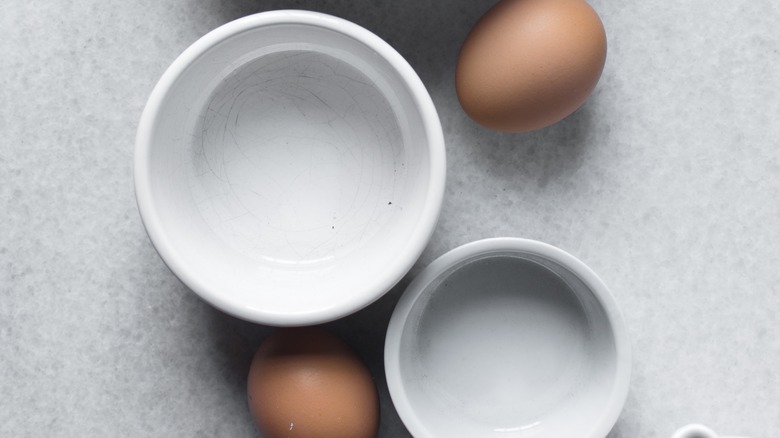
Perfectly poached eggs with runny yolks are a brunch icon that can add a touch of luxury to any dish — even avocado toast. In fact, these eggs may have even taken the place of a traditional eggs Benedict. Though impressive, poached eggs can be tricky to make, especially when you’re trying to cook multiple eggs at the same time. With your slow cooker’s help, however, you can prepare them with ease.
These slow-cooked eggs can be more accurately described as coddled eggs since the hot water doesn’t submerge the egg itself, but rather the vessel it’s sitting in. Nonetheless, poached and coddled eggs look and taste very similar, and if you make them in your slow cooker, you’re practically guaranteed a perfectly gooey yolk each time. This method also lowers the risk of the eggs’ exterior breaking apart, so this should be your go-to if you’re hosting brunch for a group.
When preparing coddled eggs in your slow cooker, keep the water level about ½ an inch high and turn your machine up to its highest heat setting. Make sure you allow the water to start bubbling before placing your egg-filled ramekins inside. While the whites should take about 15 minutes to set, this may vary depending on how soft you like them.
Avoid cooking scrambled eggs overnight

One of the most convenient aspects of using a slow cooker is its hands-off nature. Many recipes can be prepared and left in the cooker for eight hours or more; many folks even choose to leave their dishes in the slow cooker overnight. While this is perfectly fine for most recipes and often results in an even better dish with an incredible depth of flavor, you may want to abstain from cooking scrambled eggs overnight, regardless of how many you’re making.
This is because, although they won’t cook nearly as fast as they do on the stovetop, it’s still important to stir your slow cooker scrambled eggs so they won’t stick, brown, or cook unevenly. Ideally, you should stir them approximately once every 30 minutes, but doing so once or twice every few hours (or at least at the halfway point) will also help prevent burning. As such, it’s best to avoid batch-cooking scrambled eggs overnight, as they could end up rubbery in some places after being left stagnant for so many hours.
A slow cooker breakfast casserole, on the other hand, is more suited to overnight cooking, as the eggs are both a base and a binding agent and thus won’t need intermittent mixing. So, if you want to wake up to a delicious, easy breakfast, opt for an eggy casserole and save the scrambled eggs for waking hours.
Don’t be fooled by a browned top (or bottom)
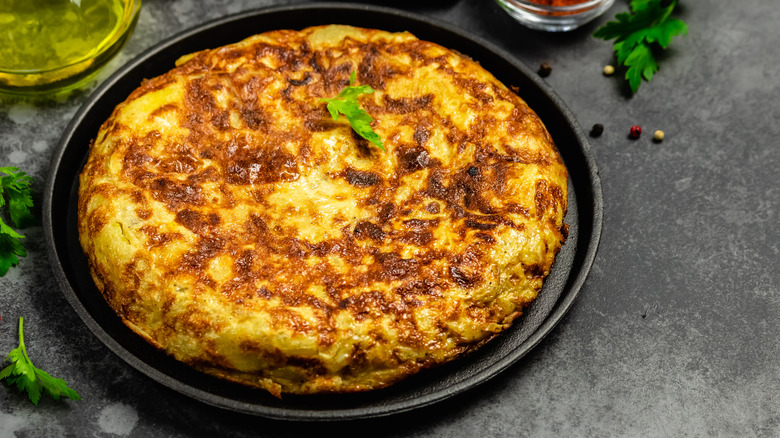
When cooking eggs in the slow cooker, you may notice that parts of them brown quicker than others. Most often, this occurs on the bottom, which becomes evident if you mix them during cooking. This may be because your slow cooker’s temperature is too high, which is why it’s best to opt for the lowest setting. Similarly, when cooking a frittata or breakfast casserole, you may notice that the top starts to brown, making the dish appear as though it’s ready. This doesn’t, however, mean that the eggs are cooked all the way through, and if you stop the cooking process here, you could end up with soggy pockets of undercooked eggs in the middle of your dish.
Though it may be tempting to turn off the cooker as soon as you see any signs of browning or crispness, insert a sharp knife or skewer into the middle first so you can see whether or not the center is cooked through. This will give you a much clearer idea of how much more time your dish needs. Similarly, if the top, sides, and bottom of your dish are browning far faster than the majority of the eggs, then you’ll know it’s time to turn the heat down.
Use liners to help with clean-up
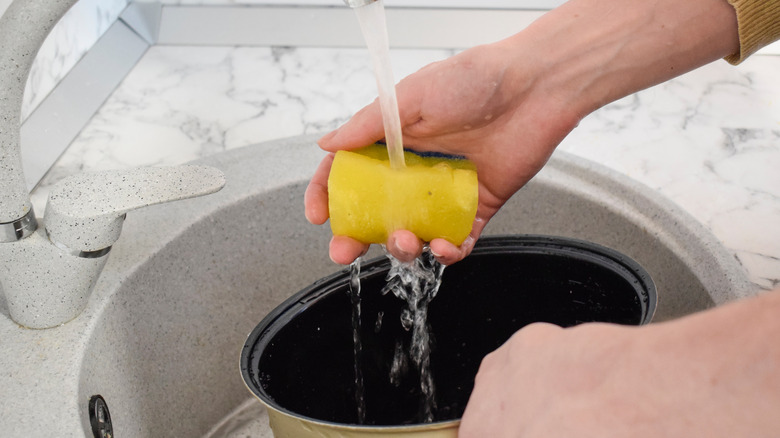
Though a slow cooker that’s been properly greased with butter shouldn’t leave many egg remnants behind, this doesn’t mean that it won’t need a thorough cleaning. Slow cookers, as a result of their long cooking times, are prone to stains and morsels of burnt-on food, which, when left, can become difficult to remove. After many uses, it’s quite likely that your slow cooker will need a deep clean, but this isn’t something you want to be doing every time you cook, especially if you’re only making a batch of scrambled eggs for breakfast.
For such applications, slow cooker liners are particularly useful, as they eliminate all mess and are easily disposed of — just lift your liner out of your cooker’s base (once it’s cool, of course) and throw it away, along with any leftover pieces of food. These liners form a protective layer between the machine’s base and the ingredients inside, meaning you no longer need to line the cooker with butter or oil and can reduce the amount of fat in your eggs if you so choose. Of course, it’s worth being mindful of how often you use single-use plastic, but these liners are certainly helpful if you want to quickly whip up an egg dish and don’t want to spend the rest of your morning tidying up.
Keep cooked eggs warm with the low setting
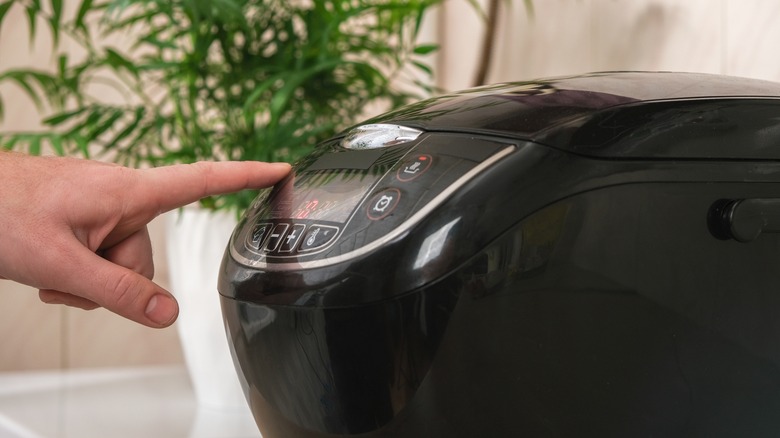
If you’ve just finished cooking a beautifully fluffy batch of scrambled eggs, you definitely don’t want to jeopardize your efforts by letting your eggs get cold and rubbery. Because of their surface area, scrambled eggs cool down quicker than other breakfast items, and reheating them may only dry them out further. Cooking your eggs in a slow cooker minimizes the risk of your eggs becoming cold or dry, as you can keep them warm in the cooker until you’re ready to serve. Fewer transfers from plate to plate means less heat can escape — plus, there will be fewer dishes to wash.
When your eggs look ready, turn the heat down and let them sit in the residual warmth. Be mindful, though, that they may keep cooking, so add a few drops of heavy cream and stir if it looks like the eggs are losing moisture. For this same reason, you’ll also want to keep your cooker on its lowest setting — some slow cookers even have a specific “keep warm” function built in. When the time comes to serve, you can make sure that your eggs stay warm at the table by serving them directly from the slow cooker.







